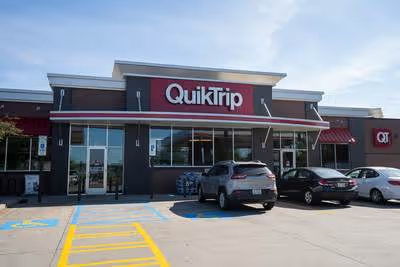

Convenience stores have long been known for their quick and easy access to snacks, beverages, and basic necessities. However, in recent years, these stores have undergone a significant transformation in their food service offerings. With changing consumer preferences and increased competition, convenience stores have had to adapt and innovate to stay relevant in the market. In this article, we will explore the current trends in convenience store food services, examine the shift in consumer preferences, and highlight the innovative responses from convenience stores to meet these changing demands.
Convenience stores have witnessed a surge in food service sales in recent years. According to preliminary data from the 2022 NACS State of the Industry survey, total foodservice sales in convenience stores grew by 14.3%. This growth can be attributed to convenience stores remodeling their spaces to focus on foodservice and offering elevated, made-to-order meal options. In response to the COVID-19 pandemic, consumers sought to minimize their interactions and make fewer stops, leading them to rely on convenience stores for their food needs. As a result, convenience stores have expanded their foodservice offerings beyond basic items to include a variety of fresh, grab-and-go meals.
In today's fast-paced world, convenience stores have become more than just quick stop shops; they are evolving into food service destinations, catering to customers' needs for speed, variety, and quality.
One notable trend in convenience store food services is the emphasis on quality and freshness. Consumers are now looking for convenience without compromising on the taste and healthiness of their food. This shift in consumer preferences has prompted convenience stores to invest in high-quality ingredients and culinary expertise to deliver a restaurant-like experience. For instance, brands like Twice Daily have redesigned their stores to feature wide aisles, built-in refrigerators, and coffee bars, creating a more upscale and inviting atmosphere.
Another trend observed in convenience store food services is the customization of meal options. Consumers are increasingly seeking personalized food experiences, and convenience stores have responded by offering customizable menu items. Whether it's the ability to choose toppings and condiments or the option to build their own meal combinations, convenience stores are catering to individual preferences and dietary restrictions. This customization not only enhances the customer experience but also allows convenience stores to differentiate themselves from competitors.
The shift in consumer preferences has played a significant role in shaping the evolving food service trends in convenience stores. In the past, convenience stores were primarily associated with the "Cokes, smokes, and gas" model, where their offerings were limited to basic snacks, beverages, and fuel. However, as fuel margins have decreased and consumers have become more health-conscious, convenience stores have had to rethink their business models.

One key change in consumer preferences is the increasing focus on better-for-you options. Consumers are now more conscious of their dietary choices and seek healthier alternatives even in convenience stores. This has led to the introduction of fresh, nutrient-rich foods, and the availability of options like salads, fruit cups, and whole-grain snacks. Convenience stores have also embraced the trend of offering a mix of indulgent and healthier fare, recognizing that consumers still desire occasional treats alongside healthier meal options.
Moreover, consumers are now prioritizing convenience and quality when it comes to their food choices. The rise of on-the-go lifestyles has led to an increased demand for quick and easy meal solutions. Convenience stores have capitalized on this by expanding their foodservice offerings and providing ready-to-eat meals and snacks that can be enjoyed anywhere. With the remodeling of their stores and the addition of amenities like seating areas and free Wi-Fi, convenience stores have transformed into destinations where consumers can dine-in or grab meals for later.
Convenience stores have responded to the changing consumer preferences and market trends with innovative business strategies and retail innovations. One such strategy is the emphasis on foodservice as a growth vehicle. Recognizing the potential of foodservice in driving sales, convenience stores have invested in developing their own food programs and menus. Companies like Wawa and Sheetz have dedicated resources to create a culinary experience within their stores, employing chefs, nutritionists, and food scientists to ensure the quality and taste of their offerings.
In addition to developing their own food programs, convenience stores have also explored partnerships and collaborations to expand their foodservice options. For example, Wawa ended its partnerships with other chains in the 90s and focused on developing its own products. This move allowed them to have full control over their menu and tailor it to the preferences of their customers. Convenience stores have also leveraged technology to enhance their foodservice offerings. Touchscreen ordering systems, mobile apps for ordering and delivery, and loyalty programs have become common features in convenience store food services, providing customers with convenience and rewards for their purchases.
Furthermore, convenience stores have embraced retail innovation to create a unique and appealing customer experience. Store redesigns, with attention to aesthetics, spacious layouts, and natural lighting, have become common in the industry. This modernization of convenience stores has helped position them as more than just a place to grab a quick snack, but as destinations where customers can enjoy a meal and relax.
The foodservice landscape in convenience stores has undergone significant changes in response to evolving consumer preferences and market trends. Convenience stores have transformed their offerings, focusing on quality, customization, and convenience to meet the demands of their customers. By investing in foodservice as a growth vehicle, convenience stores have successfully carved a niche for themselves in the competitive food industry.
Looking ahead, convenience stores will need to continue adapting and innovating to stay ahead of the curve. Keeping a pulse on consumer preferences, integrating technology, and constantly refining their food programs will be crucial for convenience stores to remain relevant and competitive. As the foodservice landscape continues to evolve, convenience stores have the opportunity to become go-to destinations for consumers seeking convenient, high-quality, and personalized meal options.
By staying attuned to the latest food service trends, convenience stores can continue to thrive and meet the evolving needs of their customers, solidifying their position as important players in the food industry.